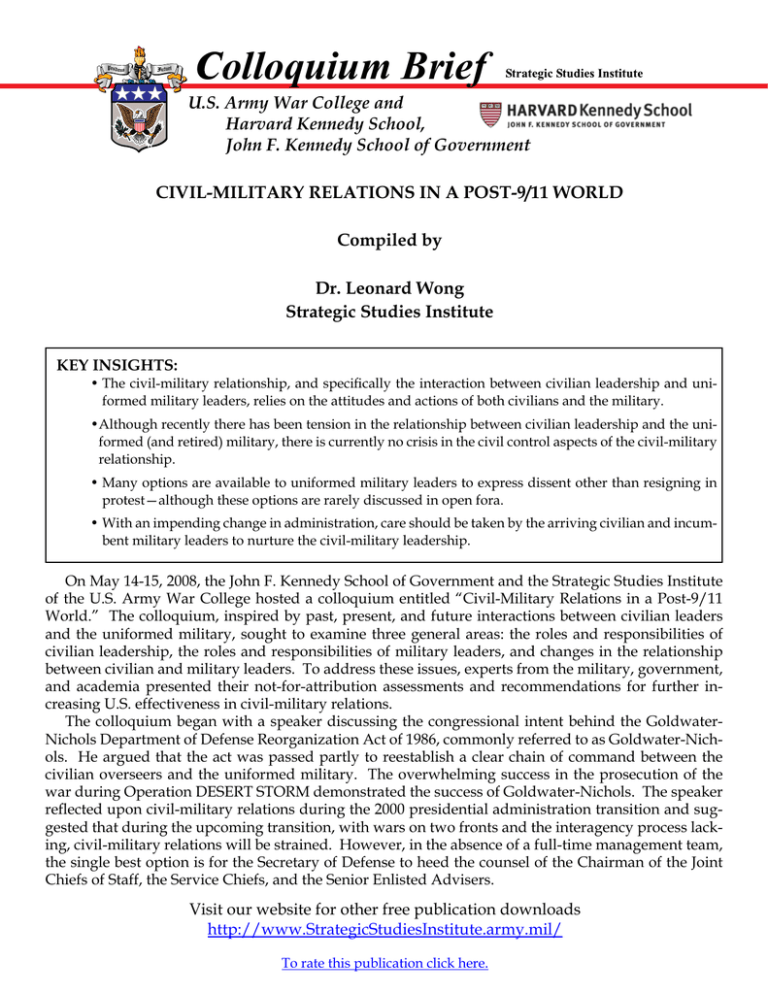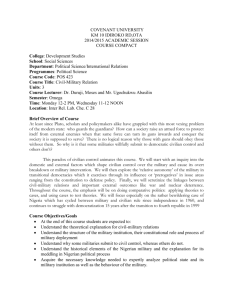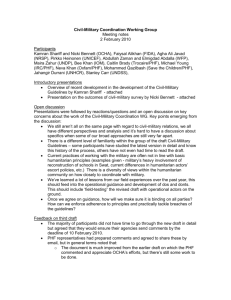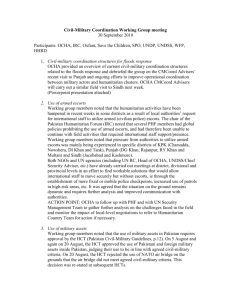Colloquium Brief U.S. Army War College and Harvard Kennedy School,
advertisement

Colloquium Brief U.S. Army War College and Harvard Kennedy School, John F. Kennedy School of Government CIVIL-MILITARY RELATIONS IN A POST-9/11 WORLD Compiled by Dr. Leonard Wong Strategic Studies Institute KEY INSIGHTS: • The civil-military relationship, and specifically the interaction between civilian leadership and uniformed military leaders, relies on the attitudes and actions of both civilians and the military. •Although recently there has been tension in the relationship between civilian leadership and the uniformed (and retired) military, there is currently no crisis in the civil control aspects of the civil-military relationship. • Many options are available to uniformed military leaders to express dissent other than resigning in protest—although these options are rarely discussed in open fora. • With an impending change in administration, care should be taken by the arriving civilian and incumbent military leaders to nurture the civil-military leadership. On May 14-15, 2008, the John F. Kennedy School of Government and the Strategic Studies Institute of the U.S. Army War College hosted a colloquium entitled “Civil-Military Relations in a Post-9/11 World.” The colloquium, inspired by past, present, and future interactions between civilian leaders and the uniformed military, sought to examine three general areas: the roles and responsibilities of civilian leadership, the roles and responsibilities of military leaders, and changes in the relationship between civilian and military leaders. To address these issues, experts from the military, government, and academia presented their not-for-attribution assessments and recommendations for further increasing U.S. effectiveness in civil-military relations. The colloquium began with a speaker discussing the congressional intent behind the GoldwaterNichols Department of Defense Reorganization Act of 1986, commonly referred to as Goldwater-Nichols. He argued that the act was passed partly to reestablish a clear chain of command between the civilian overseers and the uniformed military. The overwhelming success in the prosecution of the war during Operation DESERT STORM demonstrated the success of Goldwater-Nichols. The speaker reflected upon civil-military relations during the 2000 presidential administration transition and suggested that during the upcoming transition, with wars on two fronts and the interagency process lacking, civil-military relations will be strained. However, in the absence of a full-time management team, the single best option is for the Secretary of Defense to heed the counsel of the Chairman of the Joint Chiefs of Staff, the Service Chiefs, and the Senior Enlisted Advisers. Visit our website for other free publication downloads http://www.StrategicStudiesInstitute.army.mil/ To rate this publication click here. The colloquium then heard a preliminary report on a project investigating civil-military affairs through interviews with senior leaders past and present. The project notes that civil-military affairs are all about the senior leaders and their relationships with each other. Good relations start at the top—even if that relationship is “unnatural.” When the retired military gets involved, disagreement will occur as to what is appropriate. It is difficult to decide when retired officer input moves from providing observations to becoming partisan. Some specific recommendations from the project include respecting the apolitical status of officers in positions of responsibility, accelerating the confirmation process to reduce administration transition chaos, and drawing on previous senior leaders’ experience. the military. The best Secretaries of Defense are revolutionaries (transforming the military), team players (supporting the interagency process), and fire fighters (problem solvers) who defend the institution rather than merely advocating the President’s agenda. Finally, a discussant suggested that the current situation should not be viewed as a crisis in civilmilitary relations. As such, no sense of urgency exists for a new Secretary of Defense to “fix” anything quickly. Suggestions on how a new Secretary should transition might best be held in abeyance until the next President assumes office. Panel II: What Are the Roles and Responsibilities of Military Leadership? The second panel turned its attention to the military side of the civil-military relationship. The panel began by setting the context for the discussion. A panelist argued that armed forces, including the U.S. military, have moved from a post-modern model to a hybrid model. This shift occurred in 2001 with the 9/11 attacks and included changes such as moving from a small professional military to a professional military core with an integrated reserve force, shifting from a largely hierarchical structure to a more flattened hierarchy, and changing from a largely indifferent societal attitude toward the military to a more supportive position. Within that context, the discussion moved to options available to military leaders when confronted with flawed policy formulation. One view posited that due to a strong “Can Do” spirit and a well-engrained, albeit simplistic, notion of civilian control, senior military leaders are disinclined to publicly share their disagreement with emerging national security policy. This panelist argued that many senior officers mistakenly believe that there are no alternatives other than silently executing orders, resigning, or retiring. Depending on the degree to which the civilian authorities are receptive to military advice and the magnitude of the threat to national security involved in the policy, senior military leaders can choose among many alternatives to widen the policy debate. The discussion continued with the proposition that military leaders have three trust relationships Panel I: What Are the Roles and Responsibilities of Civilian Leadership? The first panel began with an assertion that there is inherent distrust between politicians and soldiers because they come from different worlds despite their allegiance to the same Constitution. A long history of this distrust and recent history make it even harder to maintain the requisite bonds of trust and partnership. A healthy civil-military relationship will emerge when the President takes the military into his or her confidence, and makes it clear why decisions were made. Likewise, if the President is careful to avoid disputes by working closely with Congress on the defense agenda, the military (or its allies) will not have a seam between the Congress and the Executive Branch to exploit. The civil-military relationship also benefits when a national defense team is established that understands the military, treats the military with genuine respect, and holds the military accountable. A point was posited that walking away from the relationship through resignation or retiring is dangerous. It provides a club that, if used, will destroy trust in the military. Focusing on the Secretary of Defense, a participant pointed out that very few Secretaries survive their tenure, and many are in the position only for a relatively short period. The many roles of the Secretaries require not only good relations with the President, but also with Congress and 2 to consider—trust with the American people, trust with civilians in both the Congress and Executive Branch, and trust with subordinate leaders in the profession. An act of dissent should be evaluated by conducting a moral analysis of the impact on each of these relationships by the gravity of the issue to the nation, the relevance of the senior leader’s expertise to the issue, the degree of sacrifice involved, the timing of dissent, and the authenticity of the leader. The panel then considered the many options available to senior leaders as forms of dissent, ranging from acquiescence, to writing a scholarly article, to resigning in protest, to outright disobeying the policy. There was, of course, some discussion on when certain methods of “skinning the cat” were appropriate. While the panel considered options for senior military leaders during times of dissent, there was also some discussion about options available to civilian leaders in response. Another panelist, after studying the backgrounds of several successful senior military leaders, noted that success came with being comfortable working in a bureaucracy, occasionally pushing back against civilian leaders, and understanding the philosophical approach of civilian overseers. The panel considered several factors as to why the current civil-military relationship may be different from the relationship in the past. First, there may be more acrimony and perceptions of disagreement. These perceptions result from changes in technology with blogs and emails providing faster access to leaks and disagreements. Or, it could be that the military is viewing its role as not only giving military advice, but also as setting things right. Finally, more civil-military tension may exist simply because of the increased politicization of the Iraq War. A panelist pointed out that many people believe that in the usual debate about civil-military relations, there is a bright line dividing what the military and civilians should do. In reality, that line is not as bright as anticipated. One of the unintended consequences of Goldwater-Nichols was that the Combatant Commanders gained more power from the Services and OSD. This power shift, as well as other recent changes, e.g., the increasing role of contractors and the changing rules of engagement, has challenged the civilmilitary relationship. Panel III: The Civilian-Military Relationship in Perspective: What Has Changed? The third panel began by describing the recent changes in the national security arena. Currently there is a lack of consensus on what the threats, opportunities, and appropriate missions are for the military. This is partly due to an unprecedented degree of challenge with two ongoing wars, major shifts in power, nuclear weapons, global warming, growing debt, and soaring defense costs. The nation is contending with a form of warfare that seems to compress the strategic and tactical resulting in a blurring of lines between military expertise and civilian oversight. Recent civil-military clashes that occurred during the buildup to the Iraq War add to the complex environment. The high visibility of these experiences provides the potential for overcorrection in balancing the civil-military relationship. One panelist asserted that perhaps it would be prudent to stop worrying about civilians controlling the military. It is not a zero-sum game, and it is a poor assumption that this conflict is bad. Conflict between the military and civilian leadership can actually be acceptable if it is regulated. For this to happen, however, it is important to understand both the military and civilian cultures. Concluding Thoughts. The conference ended with some integrating observations. One noted that the civil-military relationship includes more than just civilian control. It also involves the allocation and exercise of war powers and the impact of the civil-military relationship on those powers. A problem with the civil-military relationship has emerged over the last quarter-century that has caused the exercise of war powers to shift from Congress to the President. Interestingly, the military has an obedient relationship with the Executive Branch, a weak relationship with Congress, and a relationship with society that is so good that it is detrimental. The American public, probably in reaction to the lessons of Vietnam, has tremendous support for those in uniform. As a result, citizens are suspect of anything or anyone not supporting sol3 diers. With this public attitude of unquestioned support, Congress is inhibited from checking presidential power. Additionally, American society feels a social responsibility (which could also be labeled as “guilt”) towards the military for enduring hardships that the vast majority of society has opted to avoid. Trying to make the soldiers’ lot the best it can be is often the only outlet for this societal obligation. Unfortunately, this perceived social responsibility combines with the military’s obedient relationship with the Executive Branch, the military’s weak relationship with Congress, and the inability of Congress to serve as a counterbalance to executive power, thus rendering the War Powers Act useless. Another conclusion asserted is that we may not yet understand what is different in today’s civil-military relationship. Even when discussing civilian control, there is a tension about what intimidation means and how it might appear from different perspectives. Additionally, an occasional erroneous belief is that stating policy with- out considering all the factors, to include military expertise, is acceptable. In a recurring theme of the colloquium, the suggestion was put forward that all parties involved in civil-military relations should be educated and equipped to participate in the relationship. ***** The views expressed in this brief are those of the author and do not necessarily reflect the official policy or position of the Department of the Army, the Department of Defense, or the U.S. Government. This colloquium brief is cleared for public release; distribution is unlimited. ***** More information on the Strategic Studies Institute’s programs may be found on the Institute’s homepage at www.StrategicStudiesInstitute.army.mil. 4





